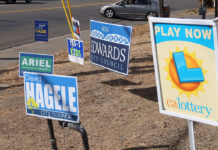Foundation facts
Editor: As President of the Board of Palm Drive Health Care Foundation (PDHCF), I want to provide a fact check about our Foundation’s mission and track record in response to last week’s article about Palm Drive Hospital’s (“Palm Drive to launch new foundation,” Jan. 9) plan to establish their own Foundation.
The article stated that, according to our Foundation’s tax reports, “less than $1 million ($983,335,000) (went) to the hospital between 2002 and 2011.” These 2-year-old numbers fail to show a current donation total to the hospital of well over $1 million, including the two most recent gifts reported in this newspaper of $150,000 to purchase the 3-D mammography machine in 2012 and a check just last July to the hospital for $105,000. I am proud to be associated with this record of giving.
The article also stated that our Foundation is “awash in red ink” and has “operated at a loss for three of the past five years.” The Foundation’s mission is not to make a profit from donor gifts but to aggregate smaller gifts in order to make new equipment purchases and improvements that are then paid out to the hospital.
The article mentioned two gifts totaling less than $15,000 made in January 2011 as evidence that “the Foundation expanded its mission…” The fact is those two grants were intended to directly support the hospital (i.e., the Senior Center grant was to provide transportation for seniors to the hospital) and did not expand the Foundation’s mission. They did re-direct funds to organizations capable of providing corollary support to the PDH.
The article unfairly compared the efforts of PDHCF to fundraising by Sonoma Valley and Healdsburg Foundations. Those two hospital-controlled Foundations mounted capital campaigns led by a well-financed capital campaign specialist and a high-profile set of community leaders. This task (a capital campaign) is not the mission of PDHCF, which has for 12 years raised well over $1 million to support improvements, and sometimes operations, at PDH.
I wish the hospital and their new Hospital Foundation well in their effort to accomplish a $20 million capital campaign. I know I plan to continue to support our Foundation and its mission, which is “to improve the health status of all residents in Western Sonoma County.”
Ed Bauman, M.Ed. Ph.D.
President PDHCF Board of Directors
No deal?
Editor: I am a new guy in West County and love the place. Because of this and despite the fractious history of the both the hospital and the Foundation, I agreed to serve on the Palm Drive Health Care Foundation Board with a belief that things were finally coming together. I was impressed with Tom Harlan as the new CEO and felt that a spirit of fellowship had dawned which I wanted to be part of.
I still felt that in late November when I met in an ad hoc committee with representatives from the hospital board and some of us from the Foundation. A week earlier at our November board meeting, the hospital board chair had presented a set of bylaws for a new entity which we were told was the only way to go and would insure the Hospital’s success. We were directed by the chair to adopt these immediately. The “bylaws” would have dissolved the governance of the Foundation and the hospital board would have immediately taken over our assets. We demurred but agreed to form an ad hoc committee with the hospital board to discuss the process for conversion.
At this time, most members of the Foundation board were willing to consider this move. The hospital appeared to be floundering financially, we had around $300,000 in donations and if the assets we had could be used to get a major capital campaign started, we were willing to talk.
For some reason I cannot explain, the hospital chair felt that adopting bylaws had to take place before anything could move forward. I am a lawyer and this is usually the last thing done in a merger. Adoption of the bylaws would immediately terminate the Foundation, transferring all assets to the hospital. My read of the ad hoc meeting was that we agreed we would work a 3-month merger, figuring out a way to responsibly transfer the money we had collected from our 13 years of donors. Everyone on our side went into the holidays with the idea that we were going to collaborate toward the idea of an eventual merger, a letter to that effect was sent to the hospital board, and we on the Foundation Board were figuring out how we would all move on to other ventures.
A day before the January board meeting, one of our members received the agenda which said the hospital board had already decided to ignore the merger and create a new foundation, saying the Foundation had rejected the proposal. So much for that ad hoc committee.
To my knowledge, the Foundation remains willing to talk about collaboration and transfer of our donor dollars. Our goal is the survival of the hospital. I have to say that, again as a newcomer with no history, the story in the paper was so surprising I wasn’t sure I was in the same room. For elected officials, it surprises me that the board so easily and unilaterally rejected the support of an organization that has been there since the formation of the hospital as well as the enormous donor base created over all those years.
Like every taxpayer in West County, I wish the board well in their new venture. I’m sorry they chose to go it alone.
Dewey Watson
Palm Drive Health Care Foundation Board of Directors
Priorities
Editor: The following is an open letter to Mayor Robert Jacob:
My priorities (in no particular order): Ives Park is in bad shape — the walkways need to be resurfaced, especially, the one to High Street, which I wouldn’t dare walk over.
The city can’t just pave the major thoroughfares and forget the small streets. Leland needs to be done; also Washington between Murphy and Nelson Way, which was scheduled to be done two years ago, but the city didn’t have the money.
I walk five miles around the city every day and see many sidewalks that need to be repaired, but it’s a waste of time and money for someone to go around marking spots to be done if it’s not taken care of, because marks will disappear in one or two years, as happened on Jewell.
It seems odd that the city will spend two weeks of time and money to pave six small blocks on Valentine Avenue when it really didn’t need it, while many other dangerous sidewalks go unrepaired, i.e. Hayden Avenue (second house from Litchfield), Fellers Lane, at the apartments and in the center of the block, Keating, which hasn’t been paved in anyone’s memory and is so dangerous to cross that it should be converted to a dirt road.
Why is the city paving the whole sidewalk next to the library on North High while other more dangerous walkways on Wilton near North High and others are not repaired?
During my walks — almost every day — I see one or more autos sitting still with the motor running while the occupant does other things, but the worst part is city employees sitting in their city vehicles with the motor on while eating lunch or whatever, all of which pollutes everyone’s air, contributes to global warming and is counterproductive to what the city claims to be doing with their solar panels. Why doesn’t the city educate its employees and all its residents?
What is the city going to do about the drought we’re in? Action to conserve water needs to be taken now before it’s too late.
Len Baron
Sebastopol
Real ‘confusion’
Editor: Your front-page story last week emphasized how “confusing” signing up for health insurance under the Affordable Care Act can be (“Confusing healthcare enrollment proving worth it to many,” Jan. 9). While that may have been the case for some, the experience in our family was the opposite. We found that it was far less confusing to enroll in Covered California than it was to buy health insurance on the open market, which we had to do last year when our Cal-Cobra ran out.
With Covered California I created an account, filled in basic information, stated income for each family member, and picked a family insurance plan within 20 minutes. Covered California e-mailed a confirmation; I called the insurance company and paid the premium on Jan. 6.
Contrast that experience with what we had to go through under the old system. To begin with, when it comes to “confusion,” comparing insurance offerings was the essence of confusion. The variety of lifetime caps, of procedures covered or not, and deductibles and co-pays, etc., made it impossible for the buyer to compare. Under the ACA we are comparing like-plans to like-plans.
When it comes to tedium and hours invested in applications, nothing in the ACA comes remotely close. Last year, I filled out five separate applications for each family member. Each application was 24 pages long. Each one asked endless questions about each and every encounter with the health care system in the last 5 to 10 years, depending.
Then came the processing, equally as time-consuming. Just keeping track of the progress of each application was an adventure in insurance company bureaucracy. On top of that, the company claimed to have lost two of the applications, so I had to fill out two replacements.
For anyone who is confused about the ACA, I recommend calling the county department of Human Services at 565-5800. I found the people who took my calls to be reliable, helpful, and courteous and the wait times were short. The county also has a helpful web page at www.sonoma-county.org/healthcarereform.
Deborah Dobish
Sebastopol
48.3
F
Healdsburg
January 22, 2025







